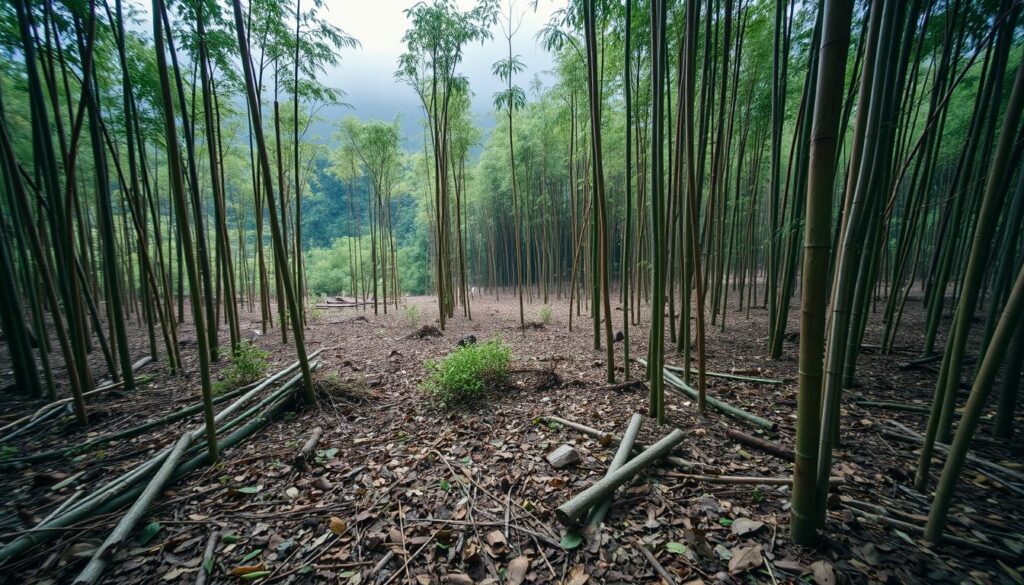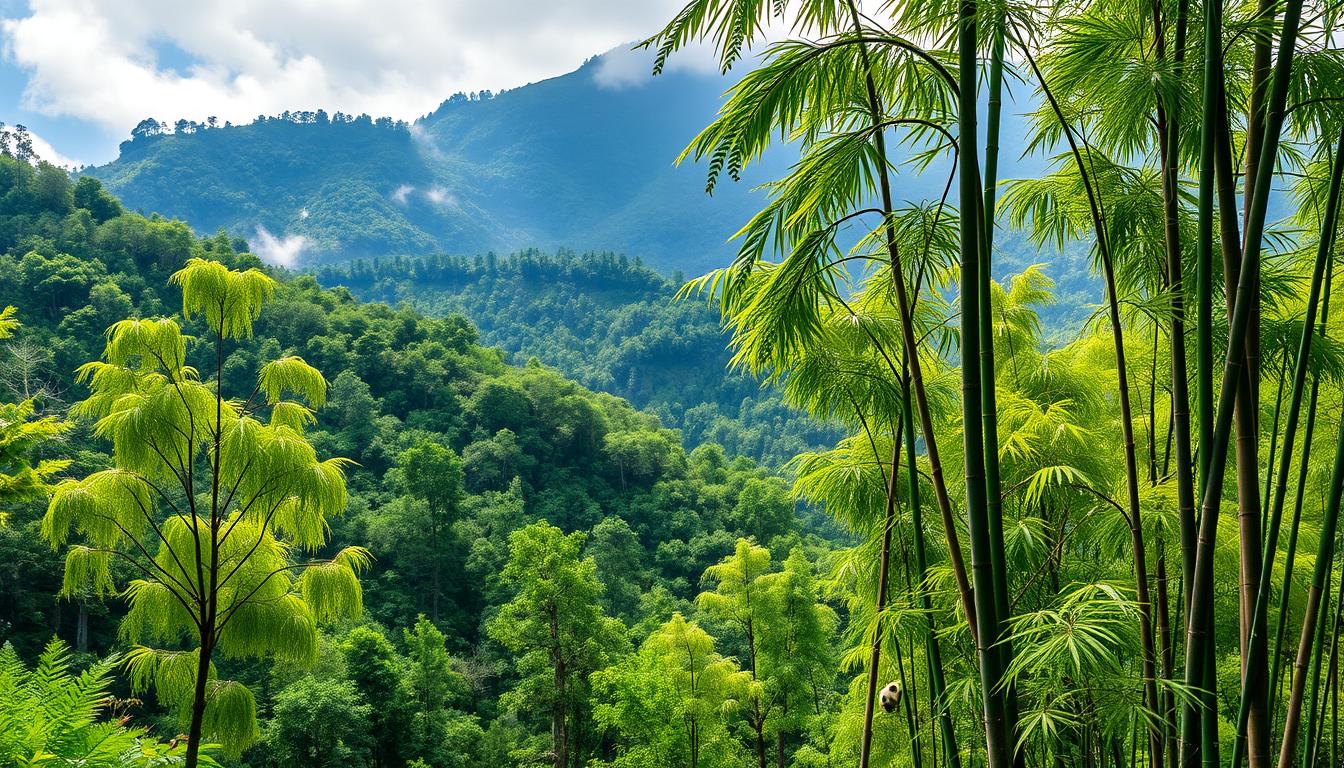The giant panda, known as Ailuropoda melanoleuca, is a beloved species Giant panda diet from central China’s bamboo forests. They are a national treasure in China and loved worldwide. Their black and white fur helps them blend in, especially in winter and summer.
Bamboo is the main part of a panda’s diet, with up to 12 kilograms eaten daily. But, their bodies struggle to digest this tough plant. They can only digest about 17% of bamboo, showing their carnivorous roots. So, they spend 12 hours eating bamboo to get enough nutrients.
Key Takeaways
- Giant pandas are native to the bamboo forests of central China and are considered a national treasure.
- Their distinctive black and white fur pattern serves as camouflage, blending into their surroundings.
- Despite consuming up to 12 kilograms of bamboo per day, pandas can only digest around 17% of it due to their carnivorous digestive system.
- Pandas must spend up to 12 hours a day feeding on bamboo to meet their nutritional needs.
- The giant panda’s habitat and diet are closely intertwined, with their survival dependent on the preservation of the bamboo forests.
The Giant Panda’s Unique Diet
Giant pandas are known for their black and white fur. But their diet is just as interesting. They are not true meat-eaters, even though they belong to the bear family. They eat up to 12 kilograms of bamboo every day, which makes up 90-98% of their diet. Yet, their body can only digest about 17% of the bamboo they consume.
Pandas are great climbers and spend up to 16 hours a day eating bamboo. They live in the mountains of central China. Their special paw helps them hold onto the tough bamboo stalks, making it easy for them to eat.
Bamboo: The Primary Food Source
Bamboo has been a giant panda’s main food for millions of years. They changed from meat-eaters to bamboo lovers. Bamboo is key to finding a good home for pandas, which are found in the mountains of central China.
- Giant pandas spend up to 16 hours a day feeding on bamboo
- Bamboo makes up 90-98% of their diet
- Pandas can only digest around 17% of the bamboo they consume
- Their distinctive paws are perfectly adapted for grasping and manipulating bamboo stalks
Even though pandas mostly eat bamboo, they still have some meat-eater traits. They have sharp teeth and claws. But their body has changed to handle the tough bamboo they eat.
“Giant pandas are not true carnivores, despite their classification as members of the bear family.”
Habitat Loss and Fragmentation

The panda’s natural home has seen big problems. A lot of its vital space has been lost. This is due to logging for timber and fuel, and for agriculture and infrastructure.
In 1998, China banned logging in panda areas. But, new roads and railways still cut through forests. This makes the landscape even more broken.
This breaking up of habitat isolates panda groups. It stops them from breeding. It also makes it hard for them to find food when bamboo dies off.
Bamboo, the pandas’ main food, naturally dies every 40-120 years. Before, pandas could move to find new food. But now, they can’t because of the broken landscape.
So, panda groups are getting smaller and more isolated. This makes them very likely to disappear. This could happen because of environmental or genetic problems, like drought or inbreeding.
Recent counts show there are about 1,864 giant pandas. They live in 20 small areas of bamboo forest. Only about 46% of their home is still safe.
| Habitat Statistic | Percentage Change |
|---|---|
| Suitable panda habitat decreased | Nearly 5% from 1976 to 2001 |
| Average size of habitat patches decreased | 23% from 1976 to 2001, with only a slight increase since then |
| Proportion of core habitats covered by protected areas | Varies between 38% and 43% under different dispersal ability scenarios |
The panda’s habitat is broken up by human actions. This includes logging, agriculture, infrastructure projects, and natural disasters. Now, efforts are to save and fix what’s left of their homes. They also want to make wildlife corridors to connect the isolated groups.
Conservation Efforts and Panda Reserves

China and global wildlife groups have focused on saving the giant panda. They’ve set up 67 panda reserves. These protect almost two-thirds of the pandas and half of their habitat.
These reserves are key to keeping the pandas safe. They protect the pandas’ bamboo homes. This helps the pandas survive for a long time.
China’s Panda Conservation Initiatives
The Smithsonian’s National Zoo has led panda conservation for over 50 years. They have a top-notch panda program. Scientists there have learned a lot about pandas, working with Chinese experts.
They’ve found new places for pandas to live. They also want to connect isolated habitats with “corridors”.
A big gift from David M. Rubenstein helped the Zoo and the Smithsonian. They have a five-year plan. It includes making corridors, fixing habitats, and studying panda reproduction.
The International Union for Conservation of Nature (IUCN) has noticed the progress. They moved the giant panda from “endangered” to “vulnerable” in 2016. This shows China’s hard work and the Smithsonian’s commitment.
They’ve trained over 1,500 Chinese wildlife experts and students. This training is in panda research and habitat programs.
“The gift from David M. Rubenstein has allowed the Zoo’s animal care and the Smithsonian Conservation Biology Institute’s scientific team to proceed with a five-year science plan established with their Chinese colleagues, with specific goals to examine the creation and impact of corridors, habitat restoration, and continue research on giant panda reproduction and management.”
Giant Panda Diet

The giant panda, known as Ailuropoda melanoleuca, has a unique diet. It eats mostly bamboo, making up over 99% of its food. This is surprising since pandas are bears, but they mostly eat plants.
Pandas need to eat 23–40 kg (50–90 lb) of bamboo daily. Their digestive system isn’t great for eating plants. They only started eating bamboo about 2 million years ago. So, they can only digest about 17% of the bamboo they eat.
Pandas spend over 10 hours a day looking for bamboo. They eat at 8–9 am and 3–4 pm in zoos. They also eat fruits, vegetables, fungi, and sometimes small animals like rodents.
| Panda Diet Breakdown | Percentage |
|---|---|
| Bamboo | Over 99% |
| Other Plant Matter (Fruits, Vegetables, Fungi) | Less than 1% |
| Small Prey (Rodents) | Rare Occurrence |
Despite looking clumsy, giant pandas are great at climbing trees and swimming. This helps them find bamboo in their habitats. Thanks to conservation, there are now 1,864 giant pandas in the wild, showing their species is strong.
Bamboo Die-offs and Adaptation

Giant pandas, one of the world’s most iconic and endangered species, face a critical challenge in the form of bamboo die-offs. Bamboo is their main food source, crucial for their survival. However, habitat loss and fragmentation make them more vulnerable to these die-offs.
Bamboo, which pandas rely on for 99% of their diet, has a natural cycle of flowering and die-off every 30 to 35 years. This cycle used to allow pandas to find new food sources. But now, with their habitat fragmented, they can’t migrate as they once did.
Navigating Bamboo Cycles
As panda populations shrink and become more isolated, they face higher risks of extinction. Factors like drought or inbreeding can harm them. These small groups can’t recover as well as larger ones, making them more vulnerable to bamboo die-offs.
Climate change models show that bamboo die-offs could make prime panda habitat uninhabitable by the end of the 21st century. This is a dire warning, showing the need for adaptation strategies to save the giant panda.
Sustainable bamboo reforestation projects are crucial for supporting pandas. They involve conservation groups, local communities, and researchers. These efforts aim to provide a steady food supply, helping pandas adapt to changing landscapes and weather.
Research and Conservation Biology

The Smithsonian’s National Zoo has led in giant panda research since 1972. Scientists have learned a lot about panda behavior, reproductive biology, and genetic relatedness. This knowledge is crucial for these amazing animals.
With Tian Tian and Mei Xiang’s arrival, the Zoo has a 10-year research plan. The Smithsonian Conservation Biology Institute is studying panda genetics. They also observe wild pandas in China, learning from them and their neighbors.
Scientists use advanced tools like geographic information systems (GIS) for censuses and surveys. They study giant pandas in the wild. This helps understand panda behavior and reproductive biology. It also guides reintroduction and wildlife corridors efforts.
The Smithsonian’s work goes beyond the lab. They work with Chinese colleagues to fight wildlife diseases. This helps protect giant pandas and other endangered species. The Smithsonian is key to the giant panda’s survival.
“The work of the Smithsonian’s National Zoo and Conservation Biology Institute has helped protect giant pandas in the wild and maintain a genetically diverse population in human care.”
Future Challenges and Opportunities

The giant panda population is growing, but challenges like habitat fragmentation and climate change are looming. The recent change in the giant panda’s IUCN status shows the success of breeding and conservation efforts. However, the fight to protect these animals is far from over.
Habitat fragmentation is a big issue for giant pandas. Populations with fewer than 30 individuals face a high risk of extinction. There are 33 giant panda populations, with about 59 pandas living in isolated areas outside the Giant Panda National Park. Inside the park, four populations with 41 individuals are isolated by roads and natural barriers, making them vulnerable to extinction.
Reintroduction and Habitat Restoration
To tackle this challenge, we need to create corridors to link fragmented habitats. This will help maintain genetic diversity and population resilience. Restoring degraded habitats, especially where pandas are making a comeback, is also crucial.
Climate change is another threat, expected to change giant panda habitats by 2050. This could provide new areas for pandas but also poses challenges for conservation. The species may need to adapt to new environments and face new threats.
Despite these challenges, there are opportunities for conservation. The Giant Panda National Park and research on panda reproduction and management offer hope. By addressing these challenges and opportunities, we can ensure a secure future for the giant panda.
| Key Statistic | Value |
|---|---|
| Populations with fewer than 30 individuals | 1 in 5 chance of going extinct in 100 years |
| Geographically isolated populations outside the Giant Panda National Park | 14 populations with 59 pandas (3% of total population) |
| Isolated populations within the national park | 4 populations with 41 individuals |
| Increase in suitable habitat by 2050 | 9.1% |
| Reduction in subsuitable habitat by 2050 | 9% |
Also Read : Sustainable Bamboo Products: How Using Bamboo Helps Protect Panda Habitats
Conclusion
The giant panda, a symbol of wildlife conservation, is facing a tough future. Habitat loss and fragmentation are big challenges. These bears need China’s bamboo forests to survive.
Despite their unique diet, giant pandas have shown they can adapt. They mainly eat bamboo, showing their resilience.
Thanks to the Chinese government and places like the Smithsonian’s National Zoo, panda numbers are stable. But, they are still at risk, as shown by their IUCN Red List status. Research on pandas helps us understand how to protect them better.
Protecting the giant panda’s habitat is key to their survival. This effort helps the planet’s biodiversity too. The panda’s story shows the importance of conservation. With hard work and new ideas, we can ensure a better future for these amazing animals.
FAQs
Q: How does habitat affect the bamboo diet of giant pandas?
A: Habitat plays a crucial role in the bamboo diet of giant pandas, as they rely on specific bamboo species that thrive in their natural environments, typically in mountainous regions at elevations of 1.8 to 3.0 kilometers.
Q: What types of bamboo do pandas eat in the wild?
A: Giant pandas typically consume a variety of bamboo species, including bamboo leaves and bamboo shoots, which make up the majority of their diet, accounting for a large amount of their daily intake.
Q: How does the elevation of their habitat influence giant pandas?
A: The elevation of their habitat influences the types of bamboo available, as different species of bamboo grow at various altitudes, impacting the availability of food sources for both adult giant pandas and panda cubs.
Q: What adaptations do pandas have for eating bamboo?
A: Giant pandas have strong teeth and a thumb-like wrist bone that allows them to grasp bamboo effectively, making it easier for them to consume the tough plant material.
Q: Are there differences in diet between male and female pandas?
A: There are no significant differences in the diet of male and female pandas; both genders primarily consume bamboo, although females may require more energy during the mating season and while nursing giant panda cubs.
Q: How do habitat changes impact the panda population in China?
A: Habitat changes, such as deforestation and climate change, can severely impact the panda population in China by reducing the availability of bamboo, leading to food scarcity for both adult giant pandas and their cubs.
Q: Do pandas in captivity have a different diet than those in the wild?
A: Yes, pandas in captivity, such as those at the San Diego Zoo, may have a more varied diet that includes specially formulated panda cakes and other food items in addition to their typical bamboo diet to ensure they receive all necessary nutrients.
Q: How does the availability of different species of bamboo affect panda breeding?
A: The availability of different species of bamboo can affect panda breeding as it impacts the overall health and reproductive success of the pandas. A reliable food source is crucial during the mating season to ensure that female pandas have the energy to breed and raise healthy giant panda cubs.
Q: What role do giant pandas play in their ecosystem?
A: Giant pandas play an important role in their ecosystem by helping to spread bamboo seeds, thus contributing to the growth and sustainability of bamboo forests, which in turn supports other wildlife.
Q: Why do pandas not hibernate like other bears?
A: Pandas do not hibernate like typical bears because their bamboo diet is available year-round, allowing them to sustain their energy levels without the need for a hibernation period.

